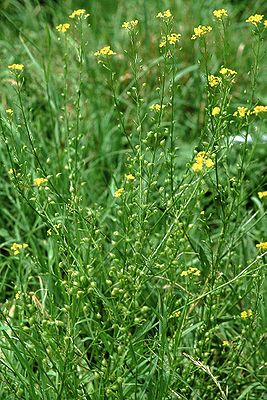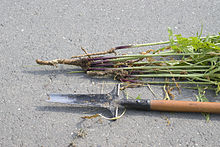Oriental serrated pod
| Oriental serrated pod | ||||||||||||
|---|---|---|---|---|---|---|---|---|---|---|---|---|

Oriental serrated pods ( Bunias orientalis ) |
||||||||||||
| Systematics | ||||||||||||
|
||||||||||||
| Scientific name | ||||||||||||
| Bunias orientalis | ||||||||||||
| L. |
The Oriental Zackenschötchen ( Bunias orientalis ), also known as the smooth Zackenschötchen or Turkish rocket , is a species of the genus Zackenschötchen ( Bunias ) within the family of the cruciferous plants (Brassicaceae). It is mainly spread from Siberia to Eastern and Southeastern Europe.
description
Vegetative characteristics
The oriental serrated pod grows as a biennial or, more rarely, perennial herbaceous plant and reaches heights of 25 to 200 centimeters. It has a spindle-shaped root. The upright stem is branched in the upper part, covered with warty humps and densely hairy to almost bald.
The lowest leaves are elongated-lanceolate with a length of up to 40 centimeters. The following leaves are pinnate and have a large, more or less triangular toothed end lobe and one or two side lobes. The uppermost leaves are usually sessile, undivided and linear-lanceolate in shape.
Generative characteristics
The flowering period extends mainly from May to August. There is an extensive, rispiger total inflorescence formed. The hermaphrodite flowers are four-fold with a double flower envelope . The four yellow petals are 5 to 8 millimeters long.
The upright fruit stalks are 7 to 17 millimeters long. The one- to two-sided pod is 5 to 10 millimeters long and oblique-egg-shaped, bumpy and wingless.
The number of chromosomes is 2n = 14.
ecology
The oriental serrated pod is a hemicryptophyte (including two-year-olds) and deep-rooted .
The pollination is often done by insects , even self-pollination occurs. The Oriental Zackenschötchen is a steppe roller with Velcro spreading of the fruits.
Occurrence
Bunias orientalis occurs from Siberia to Eastern and Southeastern Europe. Originally it only occurs regionally in Central Europe, for example in Hungary. It is increasingly spreading to Central and Northern Europe. In Switzerland the oriental serrated pod occurs only in places. Today the species is also a neophyte in other countries in Asia, Europe and North America.
The Oriental Zackenschötchen occurs in Germany in the central part scattered to widespread. In northern Germany it is so far rare or completely absent. It can be found in places south of the Danube. Mass occurrences can now be found mainly in the warm shell limestone regions of Thuringia, Northern Bavaria and Hesse, where the plant has been increasing in number, especially since the 1990s.
Neilreich reported for the first time in 1867 about a few specimens in the Prater that were probably brought in during an agricultural exhibition or by cavalry regiments in camp. In the meantime, the Zackenschötchen occurs in all federal states in Austria, scattered or rarely, and is expanding throughout the area. In the Pannonian area the species is fully naturalized, in the other areas only inconsistent in places.
The Oriental Zackenschötchen grows in Central Europe on traffic routes, on ruderal sites, in fresh meadows and on vineyards. It thrives best on chalky, moderately dry to fresh, loamy soils . It rises to Oberdorfer in the southern Black Forest on roadsides up to a height of 1400 meters.
It is a light-loving plant. According to Ellenberg , it is a semi-light plant, intermediate-continental distribution, a sign of freshness, growing in locations that are moderately nitrogenous. The Oriental is Zackenschötchen Association characteristic species Halbruderaler pioneer and loose lawn companies (Convolvulo-Elymion (= Agropyrion) repentis). According to Oberdorfer, the species is often found in Central Europe together with mugwort ( Artemisia vulgaris ) in the Arctio-Artemisietum from the Arction association, but it can also be found in societies of the Aegopodion, Convolvulion or Convolvulo-Agropyrion associations.

Invasion biology
It is a plant ( invasive plant ) that has only been introduced into Central Europe since the middle of the 20th century - sometimes it was even cultivated as a fodder plant because of its richness in protein. It continues to spread here. In the already populated locations, the plant can multiply by leaps and bounds under favorable conditions (disturbances, earth transport, unfavorable mowing regime). The oriental serrated pod produces a large number of seeds, which are distributed over long distances with the help of earth transport, mowing tools, animal feed and animals. Often the first pioneer plants can be found in freshly disturbed places, on distribution boxes, lamp posts, etc., from where the oriental serrated pod can spread surprisingly quickly. Root fragments can also form the origin of new local populations .
The plant was included in the black list of invasive neophytes in Switzerland because of its potential for spreading and the damage it causes in the areas of biodiversity , health and economy .
Control measures
The oriental serrated pod initially forms gaps, later often very dense, up to a maximum of two meters high, in which the meadow vegetation that was often originally present is largely and partially almost completely displaced. After mowing, the plants regenerate very quickly and form large rosettes of leaves. The most effective way of controlling the oriental rag pod is to cut out the entire plant with a weed picker . Mowing can prevent further spread, but must take place during the flowering period. If this happens too early, the plants can form inflorescences again; if the plants have already formed seeds, even semi-ripe seeds can develop into germinable ones. Treatment with herbicides can be the only way to control the oriental serrated pod with reasonable effort in large crops. A mulch can promote the spread of the plant, because seed germination is facilitated by the method. Plants with semi-ripe and mature seeds should be disposed of in an appropriate manner so that germination can be ruled out.
use
The young and tender shoots can be boiled or eaten as a salad. The annual root is used like horseradish.
Individual evidence
- ↑ Markus Woitke, 2001: Combination of species, establishment stage and anthropogenic disturbance regime as factors influencing the population development of the invasive Brassicaceae Bunias orientalis L. and Rorippa austriaca (Crantz) Better in experimental vegetation. Dissertation at the University of Würzburg download.
- ↑ a b c Erich Oberdorfer : Plant-sociological excursion flora for Germany and neighboring areas . With the collaboration of Angelika Schwabe and Theo Müller. 8th, heavily revised and expanded edition. Eugen Ulmer, Stuttgart (Hohenheim) 2001, ISBN 3-8001-3131-5 , pp. 453 .
- ^ Bunias in Germplasm Resources Information Network (GRIN), USDA , ARS , National Genetic Resources Program. National Germplasm Resources Laboratory, Beltsville, Maryland. Retrieved July 19, 2017.
- ↑ a b Neoflora .
- ↑ Wolfgang Adler, Alexander Ch. Mrkvicka (Ed.): The flora of Vienna - yesterday and today. The wild fern and flowering plants in the city of Vienna from the middle of the 19th century to the turn of the millennium , Vienna 2003, p. 373, ISBN 978-3900275969
- ^ Manfred A. Fischer, Karl Oswald, Wolfgang Adler: Excursion flora for Austria, Liechtenstein and South Tyrol . 3rd, improved edition. Province of Upper Austria, Biology Center of the Upper Austrian State Museums, Linz 2008, ISBN 978-3-85474-187-9 , p. 630 .
- ↑ MAIN-POST Würzburg from June 25th, 2020 - LOKALES GEM / KAR / MAR / LOH article "An intruder from the Orient"
- ↑ Invasive Neopytes: A threat to nature, health and the economy at infoflora.ch
- ^ Federal Office for the Environment FOEN: Invasive Alien Species . ( admin.ch [accessed on August 6, 2019]).
- ↑ S. Buholzer, M. Nobis, N. Schoenenberger, S. Rometsch: List of the alien invasive plants of Switzerland . Ed .: Infoflora. ( infoflora.ch [accessed on August 6, 2019]).
literature
- Henning Haeupler, Thomas Muer: picture atlas of the fern and flowering plants of Germany . Ed .: Federal Agency for Nature Conservation (= The fern and flowering plants of Germany . Volume 2 ). Eugen Ulmer, Stuttgart (Hohenheim) 2000, ISBN 3-8001-3364-4 .
- Wolfgang Adler, Karl Oswald, Raimund Fischer: Excursion flora of Austria . Ed .: Manfred A. Fischer. Eugen Ulmer, Stuttgart / Vienna 1994, ISBN 3-8001-3461-6 .
- Christian Heitz: School and excursion flora for Switzerland. Taking into account the border areas. Identification book for wild growing vascular plants . Founded by August Binz. 18th completely revised and expanded edition. Schwabe & Co., Basel 1986, ISBN 3-7965-0832-4 .
- Erich Oberdorfer : Plant-sociological excursion flora . With the collaboration of Theo Müller. 6th, revised and expanded edition. Eugen Ulmer, Stuttgart (Hohenheim) 1990, ISBN 3-8001-3454-3 .
- Konrad von Weihe (ed.): Illustrated flora. Germany and neighboring areas. Vascular cryptogams and flowering plants . Founded by August Garcke. 23rd edition. Paul Parey, Berlin / Hamburg 1972, ISBN 3-489-68034-0 .
- Siegmund Seybold (Ed.): Schmeil-Fitschen. Interactive flora of Germany. Seeing - determining - knowing. The key to the flora . CD-ROM, version 2.0. Quelle & Meyer, Wiebelsheim 2004, ISBN 3-494-01368-3 .
- Heinz Ellenberg : Vegetation of Central Europe with the Alps in an ecological, dynamic and historical perspective (= UTB for science. Large series . Volume 8104 ). 5th, heavily changed and improved edition. Eugen Ulmer, Stuttgart (Hohenheim) 1996, ISBN 3-8252-8104-3 .
- Margot Spohn, Marianne Golte-Bechtle: What is blooming there? The encyclopedia: over 1000 flowering plants from Central Europe. Kosmos, Stuttgart 2005, ISBN 3-440-10326-9 .
Web links
- Oriental serrated pod. In: FloraWeb.de.
- Distribution map for Germany. In: Floraweb .
- Bunias orientalis L. In: Info Flora , the national data and information center for Swiss flora . Retrieved October 26, 2015.
- Profile and distribution map for Bavaria . In: Botanical Information Hub of Bavaria .
- Distribution in the northern hemisphere at Den virtuella floran .
- Thomas Meyer: Data sheet with identification key and photos at Flora-de: Flora von Deutschland (old name of the website: Flowers in Swabia )
- Characteristics.
- Forage plant: [1] (PDF; 4.2 MB)
- Pictures: [2] , [3] , Oriental Zackenschote ( Memento from September 15, 2012 in the Internet Archive ), [4]




